How to use Computer Keyboard?
A computer keyboard is an essential input device for any computer. It allows users to type characters, numbers, and symbols into your computer and includes special keys that are used to perform specific functions or commands. The standard keyboard layout is known as QWERTY, which is based on the first six letters of the top row of letters on the keyboard.
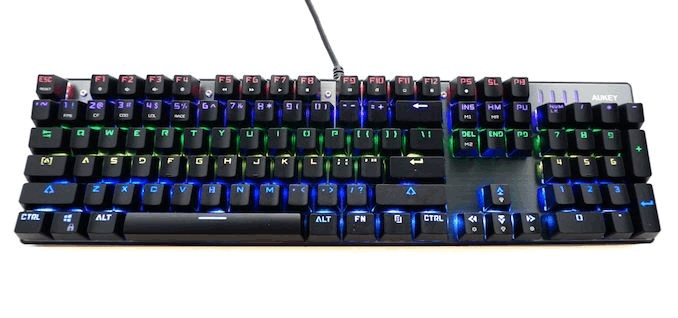
To use a computer keyboard, start by sitting in a comfortable position and placing the keyboard in front of your computer monitor. Position your hands on the keyboard with your fingers resting on the home row keys, which are the letters A, S, D, and F for the left hand and J, K, L, and; for the right hand. Use your fingers to type the letters and numbers on the keyboard. To type capital letters, hold down the Shift key while typing the letter. To use special characters or symbols, hold down the Shift key and press the appropriate key, or use the numeric keypad (if available) and press Alt or Alt + Fn.
Additionally, you can use the arrow keys, Tab, Enter, Backspace, and function keys (F1-F12) to navigate and use shortcuts on the computer. To type numbers, you can use the numeric keypad or the numbers located at the top of the keyboard. To type punctuation, you can use the keys above the letters. To use keyboard shortcuts, press and hold the “Control” (Ctrl) key and press another key. And to type different languages, you can use the input method editor (IME) or language bar to switch between languages.
Connecting the keyboard
To connect a keyboard to a computer, you will need to follow these steps:
1. Locate the appropriate port on your computer: Most computers have a USB port, which is typically located on the back or side of the computer. Some older computers may have a PS/2 port, which is typically located on the back of the computer.
2. Plug the keyboard's cable into the appropriate port: If your keyboard uses a USB cable, plug it into a USB port on your computer. If your keyboard uses a PS/2 cable, plug it into a PS/2 port on your computer.
3. Turn on your computer: Once your keyboard is connected to your computer, turn on your computer to begin using it.
4. Install any necessary drivers: If your keyboard requires special drivers or software to function properly, you may need to install them before you can use your keyboard. The drivers or software will typically come on a disc that was included with your keyboard, or you can download them from the manufacturer's website.
5. Check the settings: After connecting your keyboard, you may need to adjust the settings on your computer to ensure the keyboard is configured correctly. For example, you may need to set the language or layout of the keyboard, or you may need to adjust the speed of the cursor.
How to turn on the keyboard
Most computer keyboards do not have a power switch or button. They are powered by the computer through the USB or PS/2 port, so they turn on automatically when they are connected to the computer, and the computer is turned on.
However, some wireless keyboards or gaming keyboards may have a power switch or button. In this case, you will need to turn on the keyboard by pressing the power button or switch located on the keyboard. Once the keyboard is turned on, it should automatically connect to the computer if it's within the range of the computer and configured correctly.
It's important to note that some keyboards may have a battery that needs to be replaced or charged. Before using it, ensure the keyboard has enough charge or the batteries are new.
Also, suppose the keyboard is not working properly. In that case, you can try to disconnect the keyboard and reconnect it again or check the settings on your computer to ensure the keyboard is configured correctly.
Familiarizing yourself with the keyboard
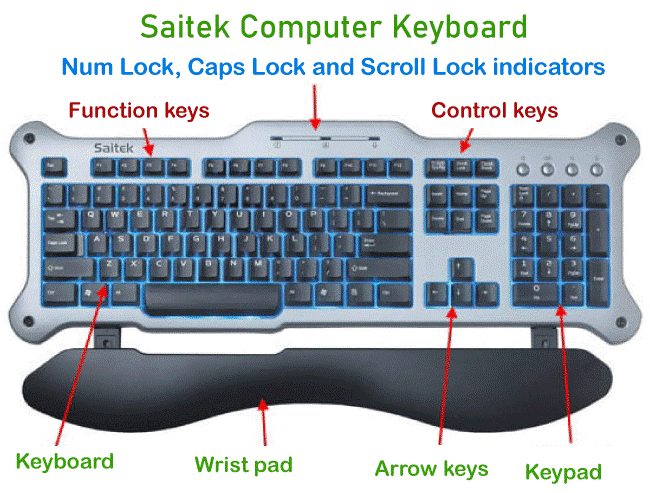
Overview of each section of the keyboard
1. Alphanumeric keyboard: An alphanumeric keyboard is a type of keyboard that includes letters and numbers, as well as a variety of other characters, such as punctuation marks and special symbols. The alphanumeric keyboard is the most common type of keyboard and is used for general-purpose computer input.
The alphanumeric keyboard layout is based on the standard QWERTY layout, which is designed to make typing easy and efficient. The keys are arranged in a grid pattern, with the letters and numbers located on the main part of the keyboard and other characters and symbols located on the top row of the keyboard or accessed through the use of the "Shift" or "Alt" key.
The alphanumeric keyboard also includes navigation keys such as the arrow keys, Tab, Enter, Backspace, and function keys (F1-F12), which help navigate and use the computer's shortcuts.
An alphanumeric keyboard also has a numeric keypad which can be used for entering numbers quickly and easily. This keypad can also be used for other functions, such as cursor movement and other special functions.
2. Function keys: Function keys are keys on a computer keyboard typically labeled F1 through F12. These keys are located at the top of a keyboard and are used to perform specific functions or commands. The function of these keys can vary depending on the operating system and the program currently running.
Some of the common uses of function keys include:
- F1: It is often used as a general help key, pressing F1 will usually bring up a help menu or documentation for the currently open program.
- F2: Its use is to rename a selected file or folder.
- F3: It is frequently used to search for a specific file or text within a document.
- F4: It is often used to open the address bar in a web browser or to repeat the last action in a program.
- F5: Its use is to refresh a webpage or to run a program in debug mode.
- F6: It is often used to move the cursor to the address bar in a web browser or to change the focus to a different part of a program.
- F7: It is commonly used to spell check or grammar check a document.
- F8: It is often used to enter Safe Mode in Windows or to access the boot menu in a computer.
- F9: It is commonly used to send or receive email.
- F10: It is frequently used to access a program's menu bar or enter BIOS in a computer.
- F11: Its use is to enter full-screen mode in a program or browser.
- F12: It is often used to open the developer console or access a program's Save As dialog box.
Control and toggle keys
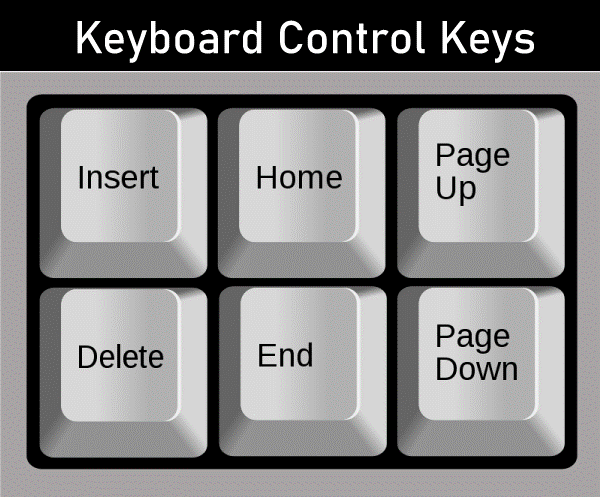
Control and toggle keys are special keys on a computer keyboard used to perform specific functions or commands.
Control keys are often labeled "Ctrl" and are used in combination with other keys to perform specific functions. Some examples of common control key shortcuts include:
- Ctrl + C: This shortcut is used to copy selected text or files.
- Ctrl + V: This shortcut is used to paste the copied text or files.
- Ctrl + X: This shortcut is used to cut selected text or files.
- Ctrl + Z: This shortcut is used to undo the last action.
- Ctrl + A: This shortcut is used to select all text or files in a document or folder.
- Ctrl + F: This shortcut is used to find specific text within a document.
- Ctrl + P: This shortcut is used to print a document.
Toggle keys are keys that switch between two states, like the Caps Lock, Num Lock, and Scroll Lock keys. These keys are used to enable or disable certain functions on the keyboard. For example, when the Caps Lock key is activated, all letters typed will be in uppercase. When it's deactivated, the letters will be in lowercase. The Num Lock key activates the numeric keypad, allowing you to type numbers instead of cursor movement, and the Scroll Lock key disables the arrow keys for scrolling and enables them for cursor movement.
Keypad
A keypad is a set of keys on a computer keyboard that is used to enter numbers. The keypad is typically located on the right side of the keyboard and is usually labeled with numbers 0 through 9, as well as arithmetic operators such as +, -, *, and /.
- Num Lock mode: When the Num Lock key is on, the keypad is used for entering numbers, and the keys work just like a calculator.
- Arrow keys mode: When the Num Lock key is off, the keypad is used for cursor movement. The keys are used to move the cursor up, down, left, and right.
The keypad can be very useful for tasks that involve a lot of numerical data entry, such as financial calculations or data entry in spreadsheets. Some keypads also include additional keys, such as the Insert, Delete, Home, and End keys, which can be used to navigate and edit text documents.
Wrist pad
A wrist pad, also known as a wrist rest, is an ergonomic device that is designed to be placed in front of a computer keyboard. The purpose of a wrist pad is to provide support for the wrists and reduce stress and strain on the hands and wrists while
typing.
Wrist pads are usually made of foam or gel and can be placed directly on a desk or table. They are designed to provide a comfortable, elevated surface for the wrists to rest on, which helps to reduce pressure on the tendons and joints in the hands and wrists. This can help to prevent injuries such as carpal tunnel syndrome and repetitive strain injury.
Arrow keys
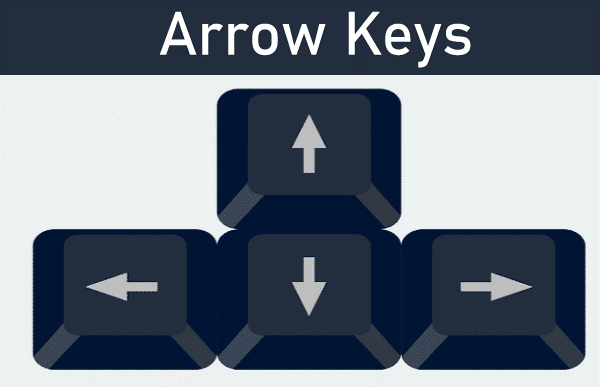
The arrow keys are a set of four keys found on a computer keyboard that is used for navigation and cursor movement. The up arrow key moves the cursor or selection upward, the down arrow key moves it downward, the left arrow key moves it to the left, and the right arrow key moves it to the right. These keys are often used in combination with other keys to perform specific actions or shortcuts.
Start typing and learn how to position your hands.
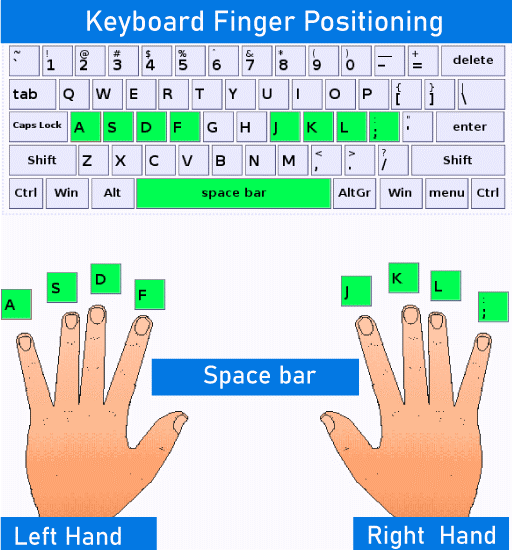
When starting to type, it's important to position your hands correctly on the keyboard to avoid strain and improve typing speed and accuracy. One common technique is the "home row" position, where the fingers rest on the following keys:
- Left hand: "ASDF" keys
- Right hand: "JKL;" keys
This positioning allows the fingers to easily reach for the other letters and symbols on the keyboard. Additionally, it's important to keep your wrists straight and avoid resting them on the edge of the desk or keyboard. Using a keyboard wrist rest or ergonomic keyboard can also help to reduce strain on the wrists.